In today’s highly competitive beauty industry, loyalty programs have become a powerful tool for brands to retain customers and foster long-term relationships that lead to more repeat purchases.
And with the rising cost of customer acquisition — beauty brands spent $7.7bn collectively on advertising in 2021 — it’s no wonder that long-term customer retention is such a big priority.
So how can you make a rewards program work for your beauty brand? Let’s learn from the best. Here are 5 of the most popular and successful beauty loyalty programs. We’ll explore the key features that make these loyalty program examples stand out, and find out why they’re so loved by their members.
LoyaltyLion helps beauty brands make millions in loyalty revenueOur beauty customers are some of our most successful:
Use our revenue forecast calculator to find out what a high-performing loyalty program could do for your beauty brand. |
The 5 best beauty loyalty programs
- Sephora’s “Beauty Insider”
- Ulta’s “Ultimate Beauty”
- MAC’s “MAC Lover”
- The Body Shop’s “Love Your Body”
- Lancôme’s “My Lancôme Rewards”
Customer retention in the beauty industry: the challenges and opportunities
Customer retention is particularly important in the beauty industry, for two reasons:
- It’s a highly-competitive and price-sensitive market, which makes it difficult and expensive to bring in new customers.
- Customers are typically highly loyal to beauty brands, so there’s lots of low-cost revenue to be earned by focusing on your existing customers.
It’s expensive and difficult to bring in new customers
The beauty and cosmetics industry is a large and growing market. In 2022, it was valued at $262.21 billion. And between 2023 and 2030, it’s predicted to expand by an average of 4.2% each year.
It’s also a remarkably resilient industry. During the 2008 financial crash, when demand for non-essential goods nosedived across a range of industries, spending barely dropped at all, after which it quickly recovered and returned to consistent year-on-year growth.
But with this powerful, sustained growth comes stiff competition, which means it’s increasingly difficult and expensive to acquire new customers.
And this comes against a backdrop of general rising acquisition costs, which are up 60% in the past 5 years.
But beauty customers are especially loyal — and this is an opportunity
In the beauty and cosmetics industry, customers are typically brand-loyal, and those most loyal customers contribute a huge proportion of overall revenues. A 2019 report by Ernst and Young notes that brand-specific customer loyalty is one of three factors that have led to an increase in revenue for beauty and cosmetics brands.
This sentiment is supported by individual case studies, too. Ulta Beauty generates a whopping 95% of its sales from members of the loyalty program.
What’s behind this unusual loyalty? Perhaps it’s the highly personal nature of the industry. What works for one person’s skin might not work for another’s, and the development of an effective skincare routine typically takes a bit of trial and error.
The continued prevalence of in-store shopping — sustained by the need to physically try a product before buying — supports this. The same Ernst and Young report notes that “despite the fact that more than 70% of purchases are influenced by online channels, physical transactions remain almost 90% of the total purchases.”
Without loyalty, smaller cosmetics retailers will fall behind the big players, some of whom are already seeing huge growth. “Health and beauty” is Amazon’s second-fastest-growing product category — behind only fashion — with a 12.1% average annual growth rate.
How loyalty programs can improve customer retention and boost revenue for beauty brands
Generally speaking, there are three ways to increase revenue from existing customers.
- First, you can get them to buy from you over a longer period of time — or “increase your average customer lifespan”.
Typically, this isn’t a problem for beauty and cosmetics brands. The need for beauty products doesn’t go away, and consumers tend to maintain beauty and skincare spending even when the economy is in the toilet.
As long as your customers like your products and your prices are reasonably competitive, they should stick around.
- Next, you can increase your “purchase rate” — how often your customers buy from you.
This can be a challenge for beauty brands, but it’s hard to influence. Customers will typically work their way through their products at a steady pace — a skincare routine is just that, a routine — and replace their products when they’ve used them up.
But cross-selling new items can increase purchase frequency if those items become part of your customer’s routine.
- But the biggest opportunity for revenue growth from existing customers is usually improving “average order value” — that is, how much customers spend with each purchase.
In the beauty industry, you know happy customers will buy from you for a long time. You also know (roughly) how often they’ll purchase. So the biggest challenge — and opportunity — is increasing how much they spend with each purchase.
You can do that by cross-selling new items that become part of their skincare routine, or by giving away targeted freebies that they might go on to purchase regularly. Or you can simply incentivize them to stock up for longer, which at least guarantees you a larger chunk of revenue.
A loyalty program can help you achieve all these things. Points-based rewards can incentivize larger purchases. Post-purchase upsells can improve order frequency and basket size. Loyalty tiers can include freebies that customers buy repeatedly in future.
But it all depends on the type of loyalty program you choose and the specific features it contains.
The four main types of loyalty program — and how they work for beauty brands
The benefits of your loyalty program will depend on the type of loyalty program you choose and the rewards you offer. The unique dynamics of the beauty and cosmetics industry make some types more suitable than others.
Points-based loyalty programs (“earn and burn”)
What it is: The “classic” loyalty program: customers earn points when they make purchases, and they can redeem those points for discounts on future purchases.
The benefits: Simple to administer and easy to plan — because you’re only giving out points for purchases, your loyalty program will almost always be profitable.
The drawbacks: Nothing major, but other kinds of loyalty programs can offer more innovative and profitable rewards.
How it suits beauty loyalty programs: Loyalty points are great for beauty brands because they increase average order value. Customers will spend more if they get rewards for their spending down the line.
Value-based loyalty programs
What it is: A lot like points-based programs, but customers are also rewarded for doing things other than making purchases, like leaving a review or referring a friend.
The benefits: Incentivizing a wider range of positive behaviors can be more effective than simply giving out points for purchases. Incentivized referrals, for example, can be a great way to bring in new customers at low cost.
The drawbacks: Value-based loyalty programs need to be carefully calculated to make sure they’re profitable. Because all points can be redeemed for purchases, you can end up losing money overall.
How it suits beauty loyalty programs: The beauty industry thrives on social engagement — the MakeupAddiction subreddit has over 5 million members — and social proof like reviews, so incentivizing social shares and reviews is a great way to structure a loyalty program. Just make sure your reward structure is ultimately profitable.
Tiered loyalty programs
What it is: Tiered loyalty programs involve levels of membership that offer increasing rewards and benefits the more a customer spends.
The benefits: Tiered loyalty programs are usually spend-based — spend $X and move into tier Y — so they’re a great way to increase average order values. Plus, offering exclusive and interesting rewards can play great on social channels.
The drawbacks: They can be complex to manage, and brands need to ensure the higher tiers offer genuinely enticing benefits to motivate customers to climb the ranks.
How it suits beauty loyalty programs: Because they’re uniquely able to increase average order values, tiered loyalty programs are a great option for beauty brands. Sephora, Mac and Ulta are all good examples of tiered beauty loyalty programs.
Paid (or “subscription”) loyalty programs
What it is: In subscription-based loyalty programs, customers pay an upfront or recurring fee to gain access to exclusive benefits. Amazon Prime is probably the most famous example.
The benefits: Guaranteed revenue from subscription fees and differentiation in price-sensitive markets from unique rewards — such as free shipping.
The drawbacks: The benefits need to be excellent to justify a subscription fee.
How it suits beauty loyalty programs: Subscription loyalty programs are best suited to commodity markets in which brands can only stand out on price — consider booksellers, for example, who all ultimately sell the same books. Such loyalty programs are less common in the beauty and cosmetics industry, where products are differentiated and consumers are loyal to the products they like.
Exploring the 5 best beauty loyalty programs — and why they’re so successful
1. Sephora’s Beauty Insider program
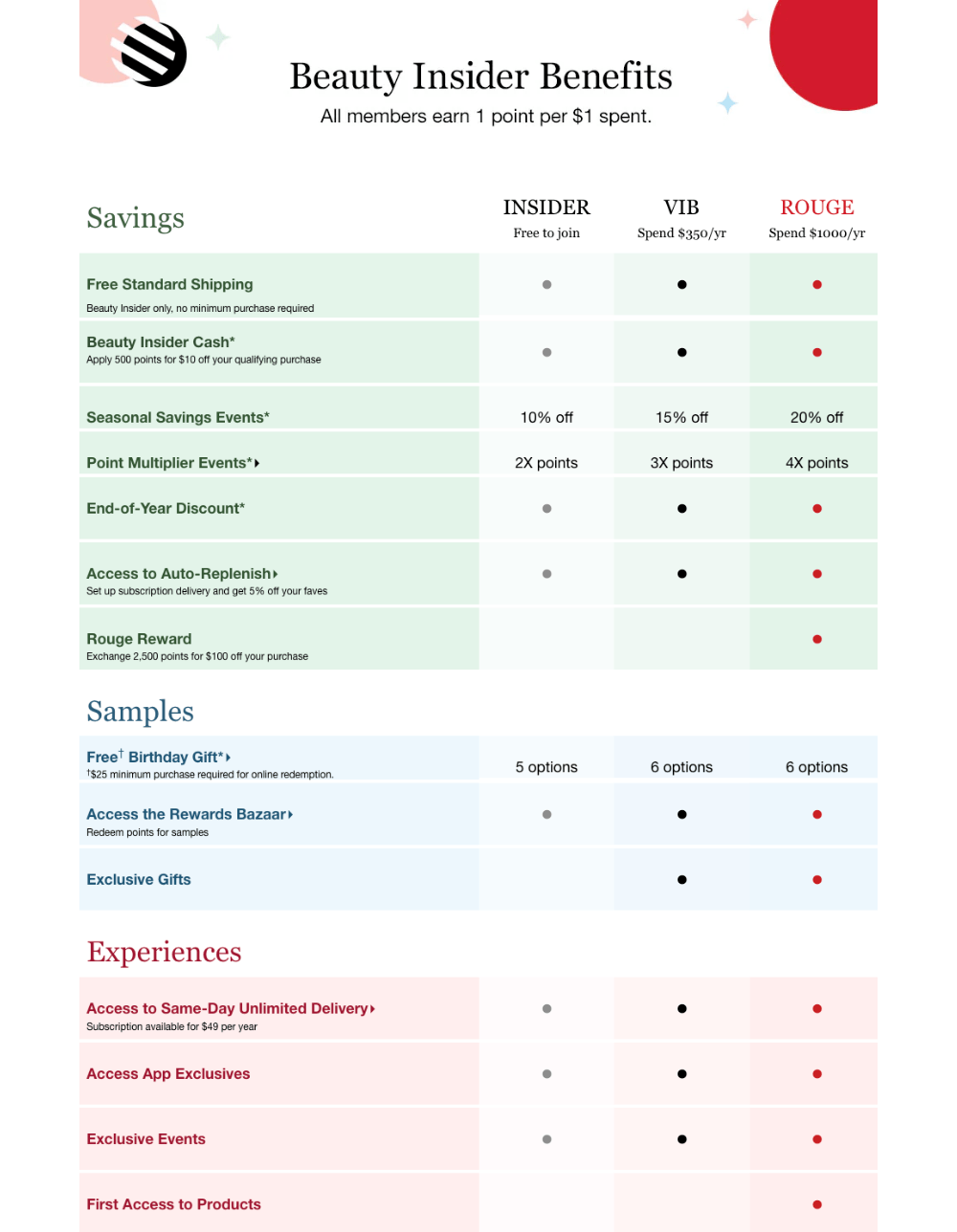
The Sephora Beauty Insider program is widely regarded as one of the best beauty loyalty programs in existence. Its effectiveness can be attributed to several key factors, here are just a few that stand out to us:
Tiered reward system: The Beauty Insider program offers a tiered system (Insider, VIB, and Rouge), each with increasing benefits. This tiered structure incentivizes customers to spend more, as they can unlock more exclusive rewards and perks. This approach keeps members engaged and motivated to reach higher tiers.
Diverse range of rewards: Sephora offers a wide range of rewards, including free beauty products, exclusive access to events, early access to sales, and even personalized beauty recommendations. This diversity ensures that members can find rewards that genuinely appeal to them, increasing the program’s attractiveness.
Birthday gifts: Sephora gives members a special birthday gift every year, which adds a personal touch to the program and makes customers feel appreciated.
The results: Beauty Insider is one of the most successful loyalty programs around, with an incredible impact on customer retention. In North America alone it boasts 17 million members, who are responsible for 80% of all sales.
Sephora credits its loyalty program with a 22% uplift in cross-sell revenue, and a 13-51% increase in up-sell revenue.
2. Ulta’s Ultamate Rewards program
Ulta’s Ultamate Rewards program is another best-in-class beauty rewards program that gets a lot of attention. And for good reason! Here are some of the reasons this loyalty scheme made the list:
Multi-tiered system: Similar to Sephora, Ulta’s program uses loyalty tiers (Member, Platinum, and Diamond). Each tier offers escalating benefits, encouraging members to spend more to unlock higher levels of rewards.
Frequent promotions: Ulta regularly runs promotions and bonus point events, creating excitement and encouraging members to shop during specific periods. This sense of urgency can lead to increased engagement and loyalty.
Ultamate Rewards credit card: Ulta offers a co-branded credit card that allows members to earn points on all purchases, both in and outside of Ulta stores. This card integration enhances the overall loyalty program experience and creates a unique and memorable touchpoint.
The results: Ultamata Rewards has over 40 million members worldwide, who contribute an astonishing 95% of sales. That kind of customer engagement and retention can dramatically reduce the pressure to spend on advertising to acquire new customers.
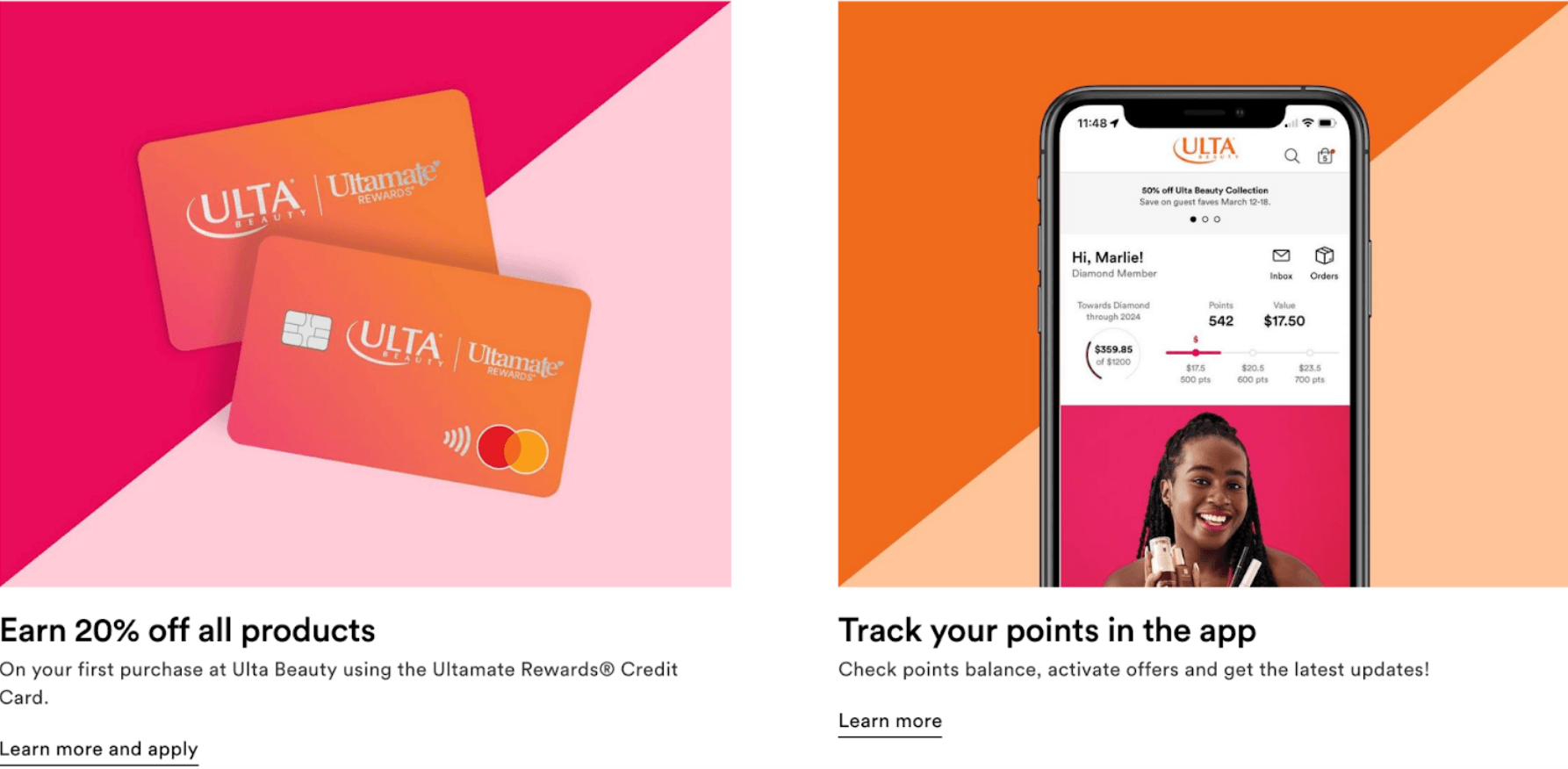
3. MAC’s MAC Lover loyalty program
Like most beauty loyalty programs, “MAC Lover” rewards customers with points for making purchases. It also makes use of loyalty tiers. MAC Lover has three tiers: “Bronze Lover”, “Silver Lover” and “Gold Lover”.
MAC have kept their products at the heart of their loyalty program. It’s a technique that works well for brands in the beauty industry as the products are visually appealing. Here’s why their rewards program resonates with customers:
Product rewards: MAC allows members to redeem their points for products, offering flexibility in how members can use their rewards. This feature ensures that members can select products they genuinely desire.
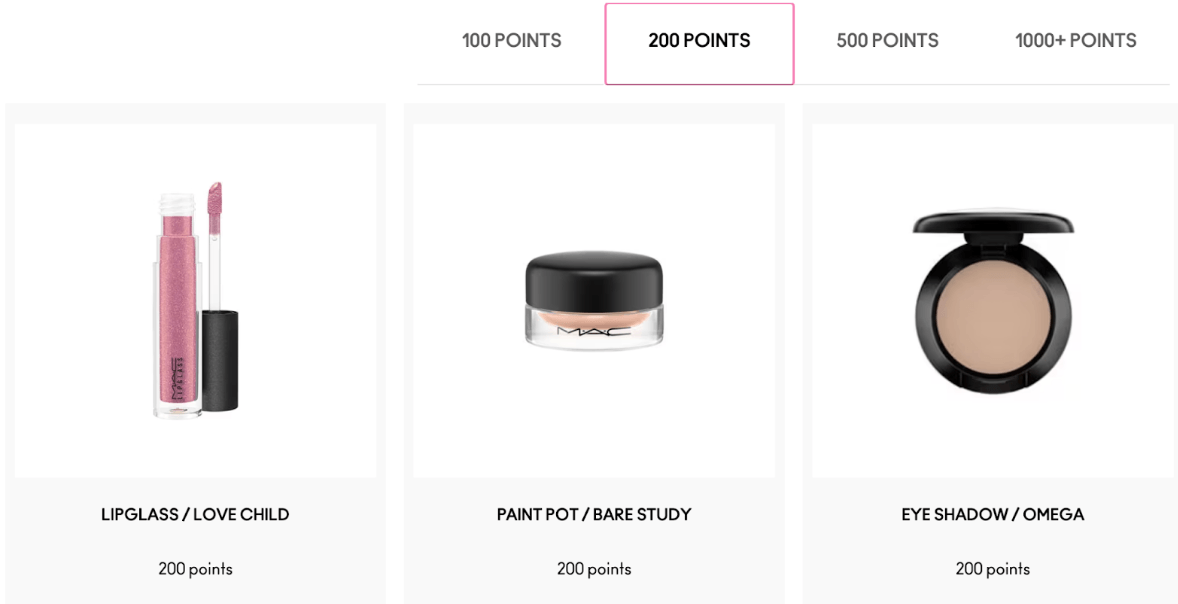
VIP events: MAC organizes exclusive events and masterclasses for its top-tier members, creating a sense of exclusivity and community. These events deepen the relationship between the brand and its loyal customers.
Exclusive products and previews: MAC offers members early access to new products and limited-edition collections. This exclusivity generates excitement among members and motivates them to stay engaged with the brand.
4. The Body Shop’s Love Your Body Club
The Body Shop’s “Love Your Body Club” has two loyalty tiers: “CLUB” (the standard tier”) and “FAN”, which customers reach by spending above a certain threshold.
One of the strongest features of the Body Shop’s loyalty card program is that it doesn’t just offer the standard points-for-purchases, but also gives members access to exclusive offers, and it incentivizes sign-ups through one-time 15% discounts for new loyalty program members.
But what really sets the “Love Your Body Club” apart is in how it aligns with the brand’s strong commitment to sustainability and ethical practices. It’s not just your typical rewards program; it’s a reflection of The Body Shop’s values and mission to make a positive impact on the planet and its people.
The Body Shop described their rewards program — which replaced a £5-to-join subscription model — as the “most generous” in retail. Some of the key features include:
Sustainability focus: Members can earn extra points for participating in eco-friendly actions, such as returning empty containers for recycling, bringing reusable bags, or participating in community events. These actions not only benefit the environment but create a sense of belonging and community.
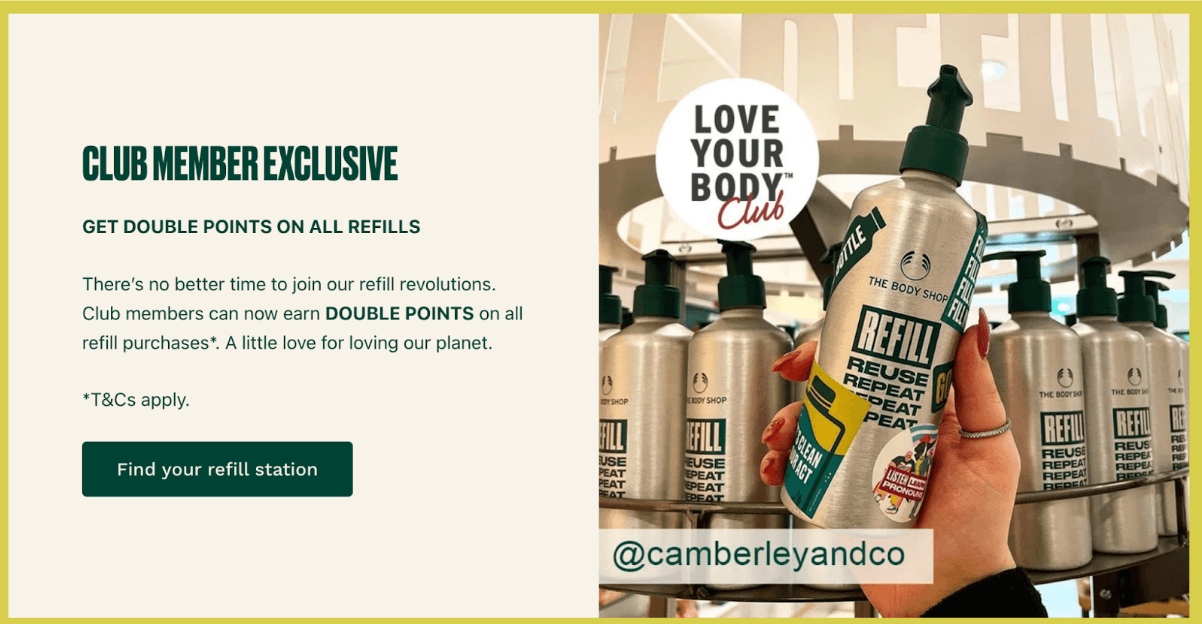
Charitable donations: Love Your Body Club members have the option to donate their earned points to The Body Shop’s charity partners, supporting various social and environmental causes. Members can feel good about themselves for supporting meaningful causes, and this will help to create an emotional connection with the brand.
Birthday gifts: All rewards program members receive a gift from The Body Shop on their birthday, making them feel appreciated, seen and valued on their special day.
5. Lancôme’s My Lancôme Rewards program
For those seeking a little luxury, Lancôme’s My Lancôme Rewards program caters to high-end beauty consumers. In addition to the standard accumulation of loyalty points, rewards program members get access to exclusive events, personalized gifts, and early access to new products.
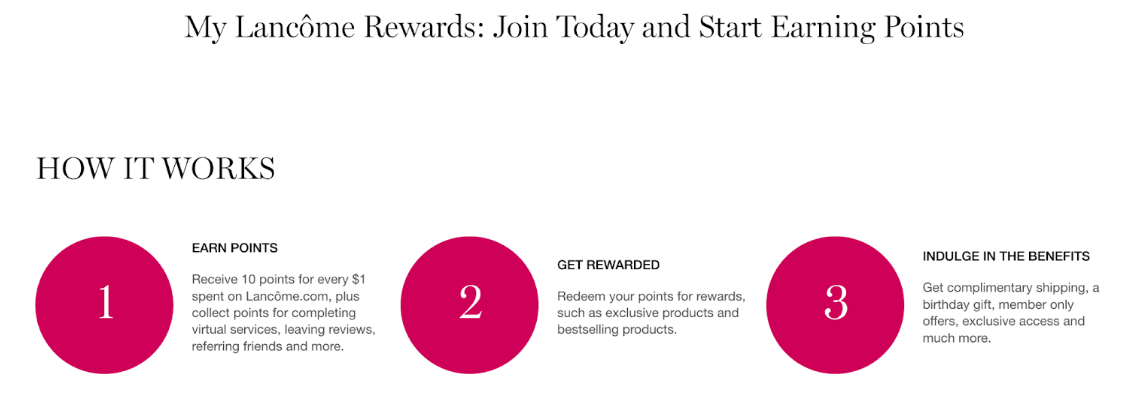
Exclusivity and luxury: Lancôme is known for its premium beauty products, and its loyalty program reflects that luxury. Members of My Lancôme Rewards are offered exclusive access to high-end skincare and makeup products, which can be particularly appealing to those who appreciate luxury beauty.
Rewards often go way beyond product discounts, with Lancôme once offering customers a chance to win a trip to Paris just for signing up to the loyalty program.
Personalization: The program offers a personalized experience for its members. Lancôme collects data about members’ preferences and purchase history to tailor product recommendations and special offers. This level of personalization enhances the shopping experience and makes members feel valued.
Tiered membership: The program includes tiered membership levels – Rose Gold, Gold and Platinum – based on how many points members have earned. Higher-tier members receive more exclusive perks, creating an aspirational element that encourages increased spending and loyalty.
What do the best beauty loyalty programs have in common?
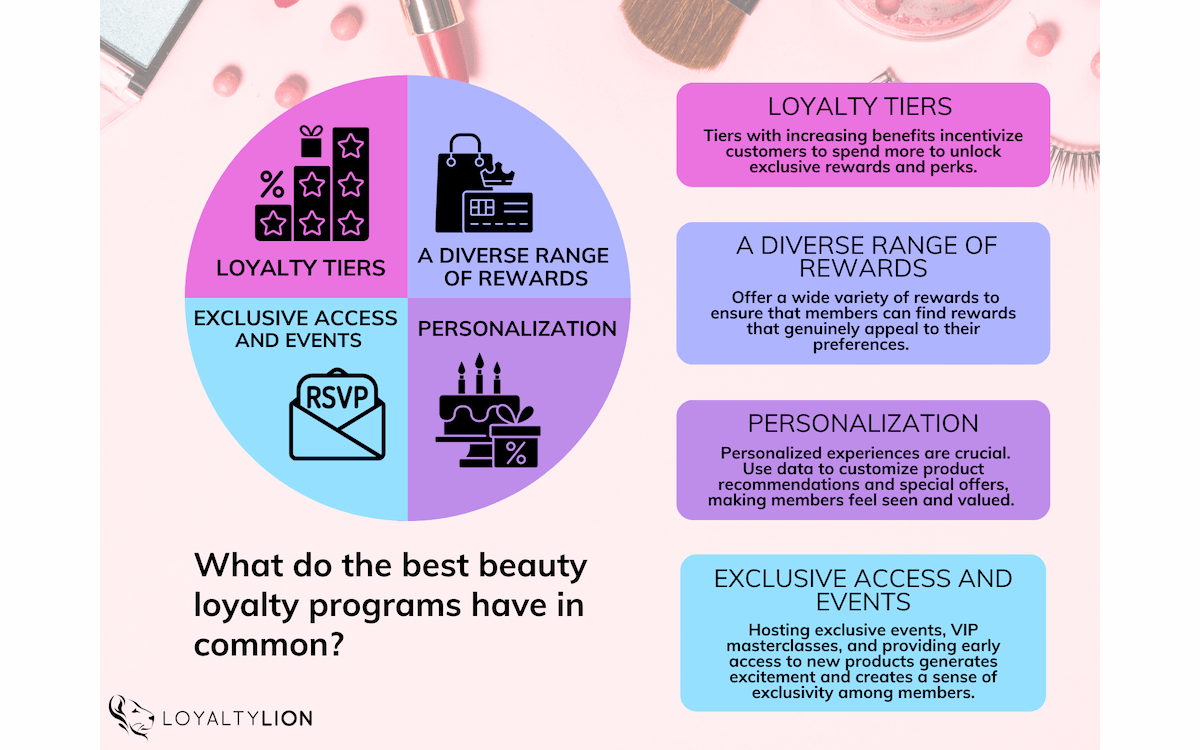
Having explored the top beauty loyalty programs and why they’re so effective, here are the key features that you should prioritize implementing into your own program:
Loyalty tiers: Many of the top beauty loyalty programs, such as Sephora’s Beauty Insider and Ulta’s Ultamate Rewards, implement tiered structures. These tiers, with increasing benefits, incentivize customers to spend more to unlock exclusive rewards and perks, fostering engagement and motivation to achieve higher status.
A diverse range of rewards: Offering a wide variety of rewards, including free products, exclusive event access, early sales access, and personalized recommendations, ensures that members can find rewards that genuinely appeal to their preferences. This diversity enhances the program’s appeal and attractiveness.
Personalization: Personalized experiences are crucial. Programs like Lancôme’s My Lancôme Rewards and Sephora’s Beauty Insider use data to customize product recommendations and special offers, making members feel seen and valued. This level of personalization enhances the overall shopping experience.
Exclusive access and events: Hosting exclusive events, VIP masterclasses, and providing early access to new products and limited-edition collections generates excitement and creates a sense of exclusivity and community among members. These elements deepen the relationship between a brand and its loyal customers.
By learning from these beauty loyalty programs and prioritizing the key features outlined here, you can create a loyalty program that sets your brand on a path to long-term success. So, what are you waiting for? Book a demo here.





